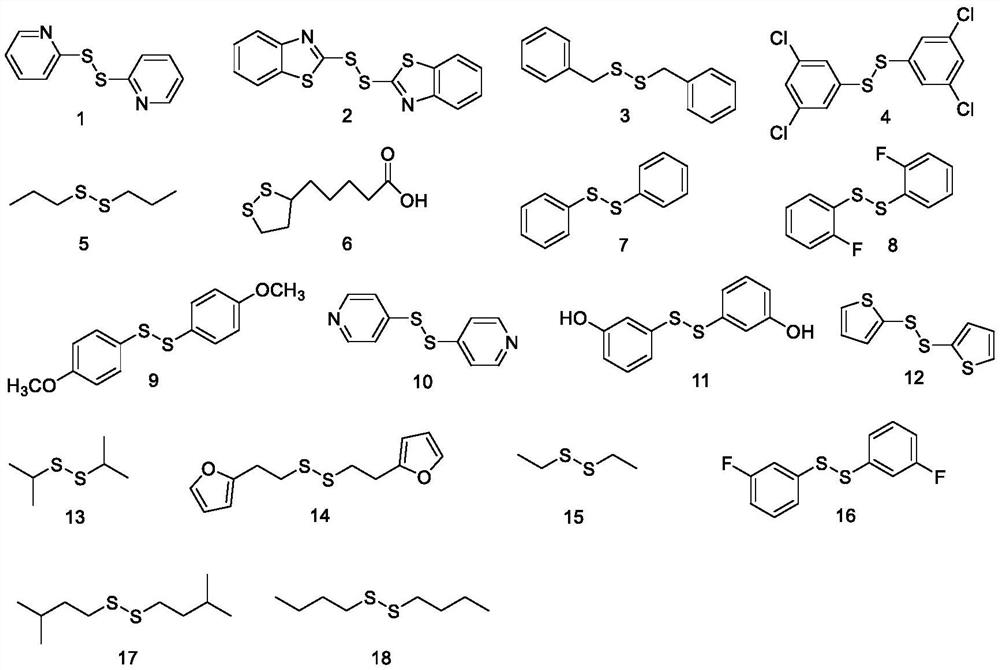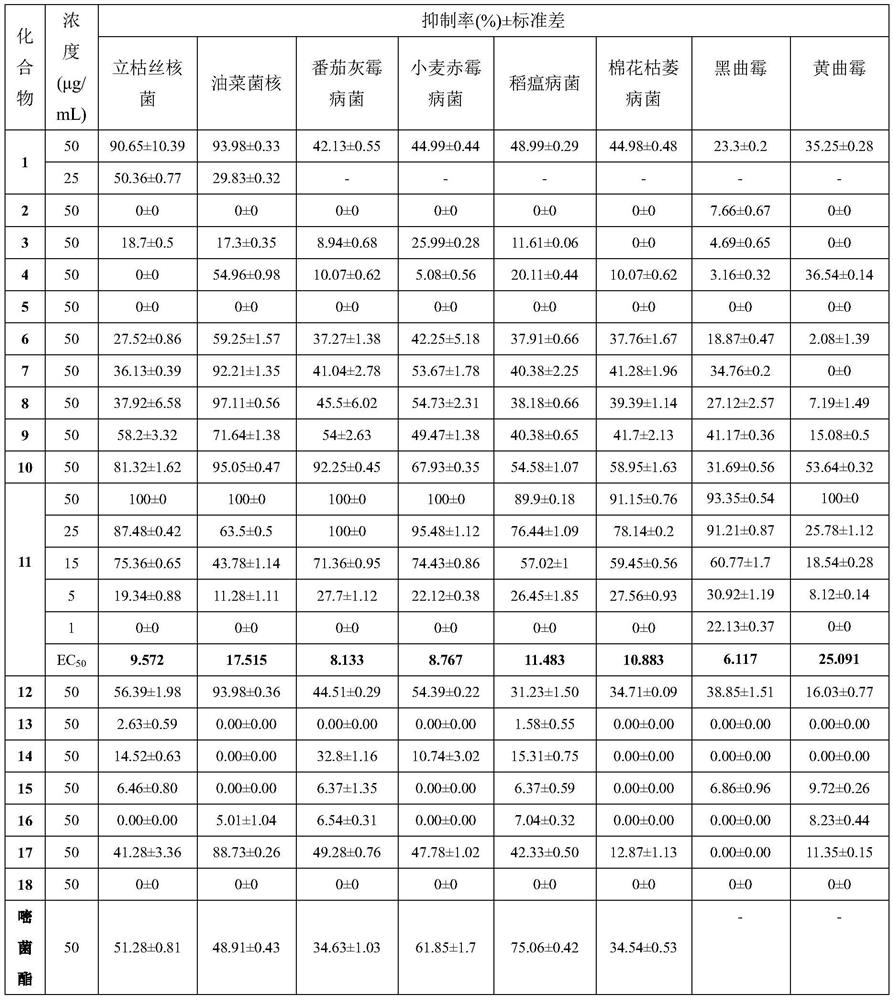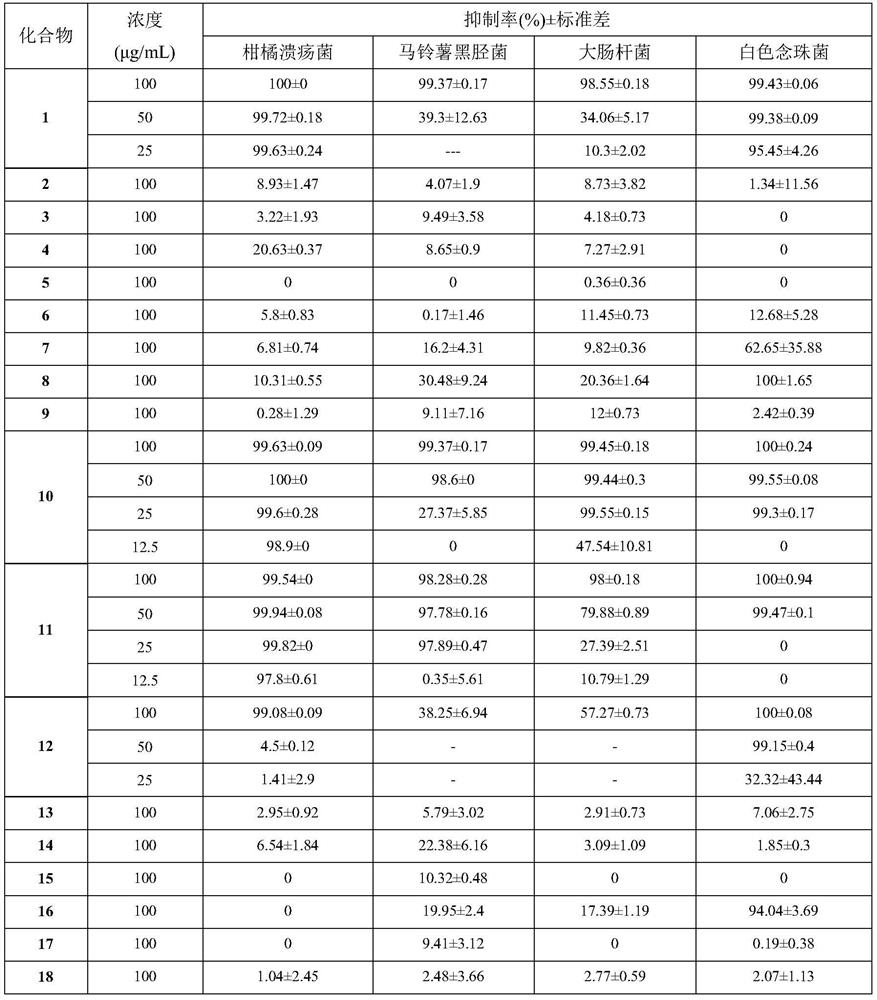Application of disulfide bond compounds in prevention and treatment of microbial diseases
A compound and disulfide bond technology, applied in the field of medicinal chemistry, can solve problems such as human hazards, and achieve the effects of not easy to produce resistance, strong bactericidal activity, and wide bactericidal spectrum
- Summary
- Abstract
- Description
- Claims
- Application Information
AI Technical Summary
Problems solved by technology
Method used
Image
Examples
Embodiment 1
[0011] Example 1: Compounds 1-18 were all isolated and their structures identified were consistent with those reported in literature.
[0012] 2,2'-dithiodipyridine (1) CAS: 2127-03-9, purity >98%; dibenzothiazole disulfide (2) CAS: 120-78-5, purity >98%; dibenzyl Disulfide (3) CAS: 150-60-7, purity >98%; 3,3',5,5'-tetrachlorodiphenyl disulfide (4) CAS: 137897-99-5, purity >99% ; Dipropyl disulfide (5) CAS: 629-19-6, purity > 99%; a-lipoic acid (6) CAS: 1077-28-7, purity > 99%; Diphenyl disulfide (7) CAS: 882-33-7, purity >99%; 2,2'-difluorodiphenyl disulfide (8) CAS: 14135-38-7, purity >98%; 4,4'-dimethoxy Diphenyl disulfide (9) CAS: 5335-87-5, purity >98%; 4,4'-bipyridyl disulfide (10) CAS: 2645-22-9, purity >98%; 3,3' - Dihydroxydiphenyl disulfide (11) CAS: 21101-56-4, purity > 98%; Bis(2-thienyl) disulfide (12) CAS: 6911-51-9, purity > 95%; Isopropyl disulfide (13) CAS: 4253-89-8, purity > 98%; Difurfuryl disulfide (14) CAS: 4437-20-1, purity > 95%; Diethyl disulfide (1...
Embodiment 2
[0013] Embodiment 2: Determination and result of indoor antifungal activity
[0014] The phytopathogenic fungi used in this experiment are laboratory-preserved strains, and the medium used is potato agar dextrose medium (abbreviated as PDA) and YPG medium.
[0015] PDA medium formula: potato (peeled) 200g, glucose 20g, agar 15g, distilled water 1000mL, natural pH.
[0016] PDA medium configuration method: wash and peel the potatoes, weigh 200g and cut them into small pieces, boil them in distilled water for about 20 minutes (the potato pieces are soft but not rotten), filter with eight layers of gauze, make up the filtrate to 1000mL with distilled water, add 15g of agar , 20g of glucose, stirred to fully dissolve, then packed in Erlenmeyer flasks, sterilized at 121°C for 20 minutes, cooled for later use.
[0017] YPG medium formula: agar 20g, glucose 5g, peptone 5g, yeast extract 5g, distilled water 1000mL, natural pH.
[0018] Preparation method of YPG medium: After adding ...
Embodiment 3
[0031] Embodiment 3: Determination of bacteriostasis activity and result of plant pathogenic bacteria and human pathogenic bacteria indoor
[0032] The phytopathogenic bacteria used in this experiment were strains preserved at -80°C in the laboratory, and the MIC value was determined by the double dilution method. Nutrient broth medium (MH for short) is used for plant pathogenic bacteria used in the laboratory, and YEPD medium is used for human-derived pathogenic bacteria.
[0033] MH medium formula: MH broth powder 21g, distilled water 1000mL, natural pH.
[0034] Preparation method of MH medium: Weigh 21g of MH broth powder into 1000mL of distilled water, stir to dissolve it fully, then divide it into Erlenmeyer flasks, sterilize at 121°C for 20 minutes, and cool down for later use.
[0035] YEPD medium formula: yeast extract 10g, peptone 20g, glucose 20g, 2mg / mL chloramphenicol aqueous solution, natural pH.
[0036] YEPD medium preparation formula: Weigh 10g of yeast extr...
PUM
 Login to View More
Login to View More Abstract
Description
Claims
Application Information
 Login to View More
Login to View More - Generate Ideas
- Intellectual Property
- Life Sciences
- Materials
- Tech Scout
- Unparalleled Data Quality
- Higher Quality Content
- 60% Fewer Hallucinations
Browse by: Latest US Patents, China's latest patents, Technical Efficacy Thesaurus, Application Domain, Technology Topic, Popular Technical Reports.
© 2025 PatSnap. All rights reserved.Legal|Privacy policy|Modern Slavery Act Transparency Statement|Sitemap|About US| Contact US: help@patsnap.com



